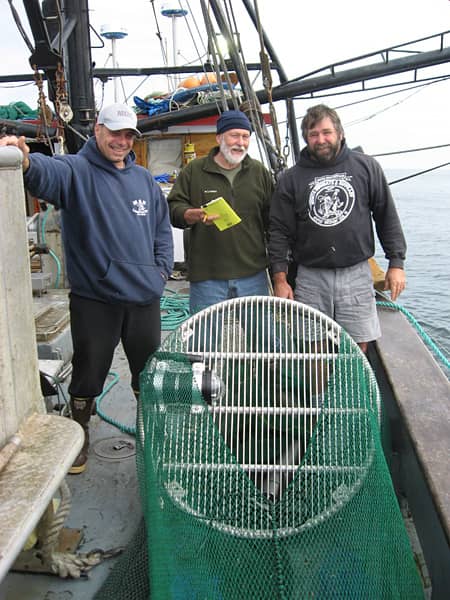Oregon Shrimpers Using Cleanest Gear Yet This Season
OutdoorHub 03.27.12

The shrimp, the whole shrimp and nothing but the shrimp, that’s what Oregon commercial shrimpers aim to catch when the season opens April 1.
Bycatch reduction devices (BRDs) have been part of the Oregon pink shrimp fishery for more than a decade, but this season the entire Oregon shrimp fleet will use the cleanest, most effective BRDs yet.
A BRD, sometimes called an excluder, is a circular metal grate with evenly-spaced bars placed in the throat of a trawl net at an angle. The spacing of the bars is large enough to let pink shrimp through, but small enough to deflect fish – and pretty much everything else – up and out a V-shaped escape hole at the top of the net. Starting this season the spacing between the bars of the grate drops to just ¾ of an inch, the smallest yet.
Bob Hannah, the pink shrimp project leader for Oregon Department of Fish and Wildlife, is quick to point out that many of the shrimp fleet already use the smaller spacing and have for the past few seasons, but this is the first season it is required by a rule set by the Oregon Fish and Wildlife Commission.
This trawl fishing method helped make Oregon pink shrimp the world’s first sustainable shrimp fishery certified by the Marine Stewardship Council. The certification was official in December 2007.
The tighter spacing on the excluder grate is aimed at preventing a small fish, called eulachon, from becoming bycatch in the Oregon pink shrimp fishery. Two years ago, the National Oceanic and Atmospheric Administration (NOAA) listed the eulachon population off the California, Oregon and Washington coasts as threatened under the U.S. Endangered Species Act.
Eulachon once swarmed from the ocean up the Columbia, Cowlitz, Lewis and Sandy rivers in huge spring migrations. These runs were a mainstay of Northwest Native Americans, the fish became known as the savior fish because they provided a plentiful food source, rich in fat, during lean winters.
In some recent years, the eulachon’s numbers have dwindled to near historic lows, although run sizes in most rivers are not well known.
The smelt are small enough they can sometimes slip through larger excluder grates and become bycatch in the pink shrimp fishery. In fact, that is one of the threats to the fish NOAA listed – along with climate change, reduced water flows in spawning streams, predation by seals, sea lions and birds, water management and habitat changes in the Klamath and Columbia River basins.
“We don’t know why the eulachon population is in decline,” said biologist Hannah. Part of their life is in saltwater before returning to freshwater to spawn. “Like other fish that spend part of their life in the ocean and part in the rivers, ocean conditions and river conditions play a huge role. If one of them is out of whack, populations can drop. On the plus side though, they can also rebuild very quickly when conditions are right.”
Hannah and his co-worker Steve Jones have studied pink shrimp for ODFW for more than two decades. They started developing BRDs in collaboration with the industry in 1994, stepping up research after the Pacific Fisheries Management Council listed some species of Oregon rockfish as overfished around 2001. The grate virtually eliminated rockfish bycatch; recent research by the two show reducing the spacing between bars can do the same for eulachon.
In a 2010 study, Hannah and Jones showed a greater than 16 percent reduction of eulachon bycatch by going from a grate with one-inch spacing to one with ¾-inch spacing. Last summer the two captured video footage of eulachon escaping from a shrimp trawl. The good news is the fish looked to be in good shape when they made their exit, easily swimming in front of the grate and out the escape hole.
The other piece of good news is that the shrimp catch didn’t suffer either. Jones said that in ODFW studies the smaller grate size did not decrease the shrimp catch. He and Hannah are also looking at other changes to shrimp trawl gear – like changes in footrope configuration – which may result in reducing eulachon bycatch still further.

